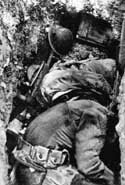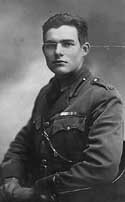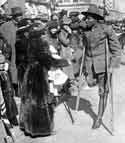The Americans are coming...! - PAGE 3

Bois de Consenvoye, France, November 8, 1918.
Three days before the armistice: Americans burying their dead.
 Click on a small photo below - and you'll get the full picture.
Click on a small photo below - and you'll get the full picture.
 Click on the large picture - and you'll get a slide show.
Click on the large picture - and you'll get a slide show.

|
|
Dead
Dead Americans of the 38th Infantry. Picture made at Mezy, on July 21, 1918.
|

|
|
Grabbing his throat
The official caption was: American soldier dies during a German gas attack.
But the picture looks staged and was perhaps made during exercises.
|

|
|
Dead Horses
American transport horses, lying dead in harness. Picture made at Cantigny, on May 28, 1918.
|

|
|
Nurses
American nurses arriving in England, enroute to France.
|

|
|
Hot Chocolate
Mary Shannon Webster, American Red Cross, serving hot chocolate.
|

|
|
Supported by an Aussie
Australian soldier (left) supporting a wounded American. Picture made on September 30, 1918.
|

|
|
Hemingway
Ernest Miller Hemingway, American Red Cross driver.
Young journalist Hemingway (1899 - 1961) joined the ambulance troops. He first served in France and later in Italy, where he was wounded.
The book he wrote about the Great War - A Farewell to Arms - brought him worldfame. In this book he keeps aloof from the usual American celebrations of power and victory: "There were many words that you could not stand to hear and finally only the names of places had dignity. Abstract words such as glory, honor, courage, or hallow were obscene", he wrote.
|

|
|
Wounded
Wounded men of the US 312th Infantry, 78 Division, being carried to an aid station. Picture made in the Negremont Wood, near Grandpré, on October 21, 1918.
|

|
|
Caring
Dressing a wound at the US Base Hospital number 18.
|

|
|
Ready for Evacuation
The Fracture Ward of the US Evacuation Station at Sebastopol.
|

|
|
To the river Meuse
American tanks advancing in the direction of the river Meuse.
|

|
|
Holding the Line
Soldiers of the US 132nd Infantry, 33rd Division, holding the line on the west bank of the river Meuse, opposite the village of Consenvoye.
|

|
|
It's Over
American troops crossing the river Moselle into Germany.
|

|
|
Coming Home
Returning soldier of the 369th who lost his leg in France, being welcomed on his return home to New York.
The loop of cord on his left shoulder is the decoration that every member of this regiment is entitled to wear. It signifies that entire regiment has been awarded the Cordon of the Croix de Guerre by the French.
|
Of the approximately 115,000 American dead in the Great War, only about 52,000 died of battlefield wounds. More than 200,000 became more or less seriously wounded. Some 60,000 soldiers and sailors died of disease, mainly the complications of the global pandemic flue (influenza).
During the war over 4,355,000 American men and women served in the armed forces. At the end of the war 1,950,000 Americans were actually fighting in France and Flanders. One in five was foreign-born and one in four was functionally illiterate.
 Back to Page 1 with pictures of the American Expeditonary Force fighting in Europe
Back to Page 1 with pictures of the American Expeditonary Force fighting in Europe
 Back to Page 2 with pictures of the American Expeditonary Force fighting in Europe
Back to Page 2 with pictures of the American Expeditonary Force fighting in Europe
Or
 Click for a large collection of pictures made in American training camps, made by photographer Lewis Wickes Hine (Kodak Archives).
Click for a large collection of pictures made in American training camps, made by photographer Lewis Wickes Hine (Kodak Archives).
 Click here for Barbara Tuchman's essay on America's entry in the Great War.
Click here for Barbara Tuchman's essay on America's entry in the Great War.
 Click here for a challenging opinion why America should have stayed out of World War I.
Click here for a challenging opinion why America should have stayed out of World War I.
 Click here for another dissent voice on the result of America's participation in the Great War.
Click here for another dissent voice on the result of America's participation in the Great War.
Or
 Straight to the frontpage of The Heritage of the Great War
Straight to the frontpage of The Heritage of the Great War

![]() Click on a small photo below - and you'll get the full picture.
Click on a small photo below - and you'll get the full picture.![]() Click on the large picture - and you'll get a slide show.
Click on the large picture - and you'll get a slide show.![]() Back to Page 1 with pictures of the American Expeditonary Force fighting in Europe
Back to Page 1 with pictures of the American Expeditonary Force fighting in Europe![]() Back to Page 2 with pictures of the American Expeditonary Force fighting in Europe
Back to Page 2 with pictures of the American Expeditonary Force fighting in Europe![]() Click for a large collection of pictures made in American training camps, made by photographer Lewis Wickes Hine (Kodak Archives).
Click for a large collection of pictures made in American training camps, made by photographer Lewis Wickes Hine (Kodak Archives).![]() Click here for Barbara Tuchman's essay on America's entry in the Great War.
Click here for Barbara Tuchman's essay on America's entry in the Great War.![]() Click here for a challenging opinion why America should have stayed out of World War I.
Click here for a challenging opinion why America should have stayed out of World War I.![]() Click here for another dissent voice on the result of America's participation in the Great War.
Click here for another dissent voice on the result of America's participation in the Great War.![]() Straight to the frontpage of The Heritage of the Great War
Straight to the frontpage of The Heritage of the Great War